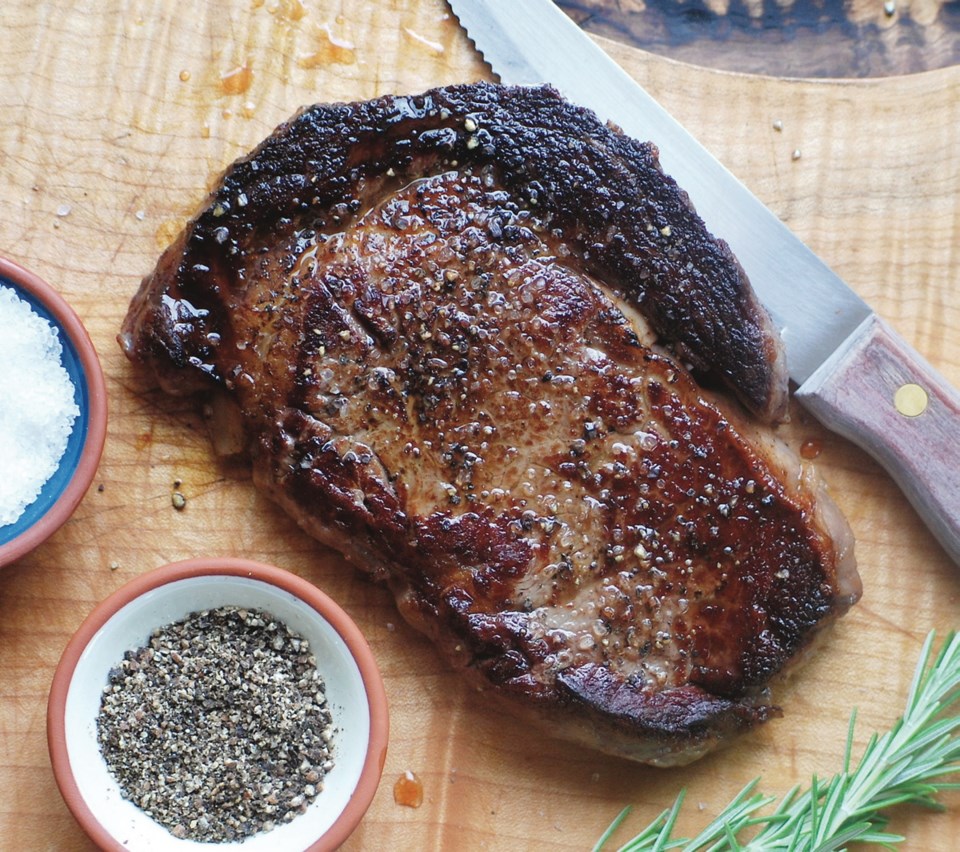An old method is literally breathing new life into a premium style of beef that’s growing in popularity and availability in Victoria and elsewhere.
That method is dry-aging and, according to the website for Canadian food wholesaler Centennial Food Service, centennialfoodservice.com, before the early 1960s it was the most popular way to tenderize beef before being deemed ready for market.
But in the 1960s use of that technique waned after the invention of vacuum packaging, which allowed beef to instead be aged in sealed plastic bags.
Meatpackers liked that practice because meat tenderizes quicker and moisture in it does not evaporate as it does while dry-aging, reducing shrinkage. The process also made it easier and less expensive to store and ship meat.
This method, which is how most beef is aged today, is called wet-aging. While in the bag, microbes and enzymes in the meat gradually work to break down connective tissues, making the meat more tender in a similar way dry-aging did.
If you eat beef, that type of product is likely what you’ve been digging into for decades.
But in recent years, dry-aging has made a comeback among meat lovers looking for the big, beefy, bold flavour it affords.
Dry-aging involves unwrapped cuts of quality beef, such as sa���ʴ�ý AAA or prime, being left to age, exposed to the air, in a dedicated room or case. Some cuts I’ve seen dry-aged include short loin (where T-bones steaks come from), tenderloin, strip loin, sirloin and rib eye. While being dry-aged, all aspects of the environment, such as temperature, humidity and air circulation are controlled.
While aging in that environment, the meat naturally becomes more tender. But most importantly for those fond of dry-aging, because the meat is exposed to the air, moisture in it slowly evaporates. That evaporation shrinks the beef, concentrating the meat’s already rich flavour, creating a robust tasting product with that big, beefy taste.
During aging, the outside of the meat also naturally darkens, creating an outer crust referred to as “bark,” which is trimmed away before the meat is sold.
How long the beef dry-ages can vary from purveyor to purveyor, but around 30 days seems to be the time required to create that big, beefy flavour. Most sources I checked suggested that dry-aging beef much longer than that would create even more intense flavours, even hints of blue cheese in the meat’s taste profile.
It must be noted that dry-aged beef is often wet-aged first simply because that is still how many meatpackers pack and ship it.
For example, Centennial Food Service produces and sells a line of dry-aged beef marketed as Vintage 67 Dry-Aged Beef. They say that product is made from beef wet-aged for a minimum of seven to 10 days, the period from harvest to transporting it to their dry-aging facility. The meat is then unpacked and dry-aged for 35 days and then sold to restaurants, food stores and butcher shops, such as Slater’s Meats (slatersmeats.com) in Victoria.
Other establishments in Greater Victoria, fitted with the proper equipment, are also dry-aging beef themselves. They include Village Butcher (villagebutcher.ca), Farm and Field Butchers (farmandfieldbutchers.com) and the Broadmead location of Thrifty Foods (thriftyfoods.com).
Some of those places also start with wet-aged beef. So when purchasing beef from one of those locations, you may want to ask what their process is to gauge how long their beef was actually dry-aged.
Because of the time and equipment required, and the shrinkage of the meat, dry-aged beef is more costly than wet-aged, about $1.50 to $2 more per kilogram.
Those who revel in its bolder flavour say it’s worth the price.
Because dry aged beef is such a pricey, premium product, you don’t really want mess up its taste by smothering or coating the meat with a heavy sauce or potent spice rub. Most often, I simply season the meat with just salt and pepper. Below, are some other cooking tips.
Cooking dry-aged
beef steaks
• Warm steaks at room temperature about an hour before cooking. This will take the chill out of the meat and help it cook more evenly. Although it is dry-aged, pat the meat dry if you notice any moisture on the surface.
• Cook dry-aged steaks as you would other types of tender steak, by methods such as grilling and pan-searing using medium-high heat. Before cooking, lightly brush meat with olive oil, and then season with sea or kosher salt and freshly ground black pepper.
• During cooking, to gauge doneness, lightly press steak in the centre. When very rare, the meat will feel quite soft; medium-rare steaks will be somewhat soft, but offer a little resistance. A medium steak will start to feel firm, but still have some give.
• If you’re a novice at gauging doneness by touch, you could also use an instant-read thermometer. When it’s inserted through the side of the steak into the centre of the thickest part of the meat, a rare steak will be about 120 F, medium-rare will be 125 F, and a medium steak will be 135 F. After cooking, let steak rest a few minutes before serving.
Eric Akis is the author of eight cookbooks. His columns appear in the Life section Wednesday and Sunday.
